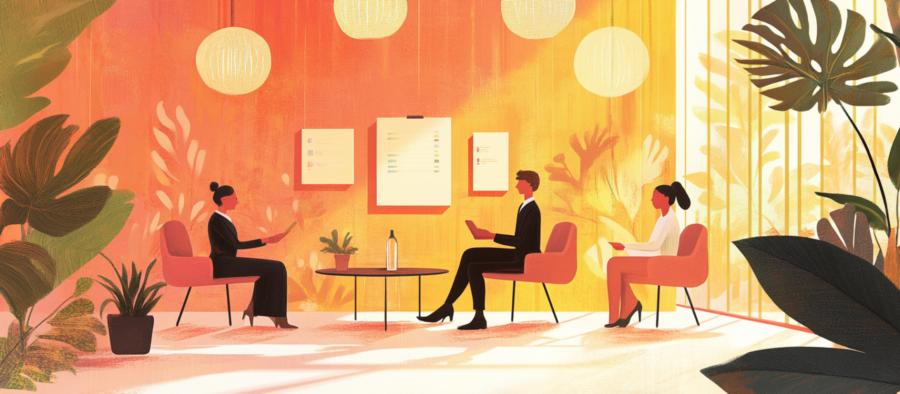Seating Arrangements: The Chessboard of Business
There’s a reason serious discussions don’t happen while sitting on bean bags in a circle. Where people sit in a room changes the balance of power—literally. Research suggests that sitting directly across from someone creates a confrontational dynamic, while sitting at a 90-degree angle encourages collaboration. That’s why many high-stakes negotiators favor a corner setup—it feels casual, but you still hold control.Then there’s the ever-powerful height dynamic. A chair that’s slightly higher than your guest’s? Subtle dominance. A chair that subtly reclines when they sit? Now they’re in a position of relaxation while you sit upright, looking like the authority. Just don’t go full supervillain and put them in a chair that sinks like a bad first date—subtlety is key.
Lighting: Turning Up the Heat (Or Cooling It Down)
Lighting isn’t just about ambiance; it has a real impact on mood and decision-making. Warmer, dimmer lighting tends to make people feel relaxed and comfortable, which is great if you want them to stay and chat—but not if you want them to make a firm decision. Brighter, cooler lighting keeps energy levels up and promotes alertness, which is ideal when you need someone to sign on the dotted line.Want to put a little pressure on the conversation? Increase the temperature slightly. Studies show that people in warmer rooms are more likely to comply with requests, perhaps because their body is already exerting energy to cool down, leaving them less willing to argue. Just don’t go too far—no one makes good decisions when they’re sweating through their dress shirt.
Wall Colors: More Than Just Office Aesthetics
You might think office walls are just there to prevent awkward open-plan eye contact, but color psychology suggests they do much more. Blue tones tend to foster trust and calmness, while green promotes balance and decisiveness. Red? Great for sparking urgency but risky—push too hard, and your client might walk away just to escape the subconscious pressure.Then there’s the ever-mysterious gray. While it might seem like a safe, neutral choice, gray walls have been linked to feelings of uncertainty and hesitation. Not exactly the vibe you want in a negotiation room. If you’re going for neutral, soft earth tones like beige or warm taupe can provide a reassuring foundation without tipping the emotional scales too far.
Furniture Placement: The Silent Power Play
Furniture layout is like a game of psychological Tetris—get it right, and everything falls into place effortlessly. A large, solid desk between you and your client reinforces authority, but it can also create an “us vs. them” dynamic. If you want to soften the approach, a round table is a classic power-equalizer, often used in diplomatic meetings to encourage collaboration (and, let’s be honest, to avoid fights over who gets the head of the table).And then there’s the mysterious effect of “anchoring.” Positioning a client’s chair slightly away from the door can subconsciously make them feel less in control of their exit, subtly encouraging them to stay longer. Meanwhile, putting a comfortable couch in the room but reserving the upright chairs for serious discussion sends a clear message: we’re here to get things done.
Acoustics: The Sound of Success
A negotiation space should be designed to keep distractions out and focus in. High ceilings can create an airy, grand feel, but they also amplify noise, making conversations feel less intimate. Meanwhile, soft surfaces like carpets and upholstered furniture absorb sound, ensuring private discussions stay private.And let’s talk about background noise. A subtle hum of white noise can prevent eavesdropping and keep conversations feeling intimate, while absolute silence can make things awkward fast. If your office tends to echo like a cathedral, consider strategically placed soundproofing elements—nothing kills a negotiation vibe faster than hearing every keyboard click from the desk next door.
Strategic Distractions: The Art of the Well-Placed Object
Sometimes, a little visual distraction can be used to your advantage. A sleek piece of art or an unusual sculpture can provide a subtle conversational pivot if things get tense. A bookshelf filled with carefully chosen titles can give the impression of depth and expertise (bonus points if your own book is casually placed front and center).Even the humble coffee table book has a role to play—putting one with a captivating title in your waiting area can get clients thinking in the right direction before they even step into the negotiation room. Just make sure it aligns with the message you want to send—“The Art of War” on display might be a little too on the nose.
Winning Before the First Handshake
An office isn’t just a place where business happens—it’s a silent participant in every deal. Thoughtfully designing your space to create the right atmosphere can subtly tilt negotiations in your favor without a single word being spoken.So the next time you’re planning an office renovation, don’t just think about what looks good—think about what works. Because when it comes to sealing deals, sometimes the smallest details make the biggest difference.
Article kindly provided by londonhomerenovation.co.uk



